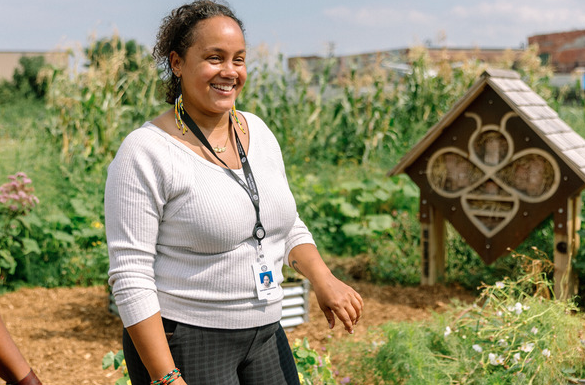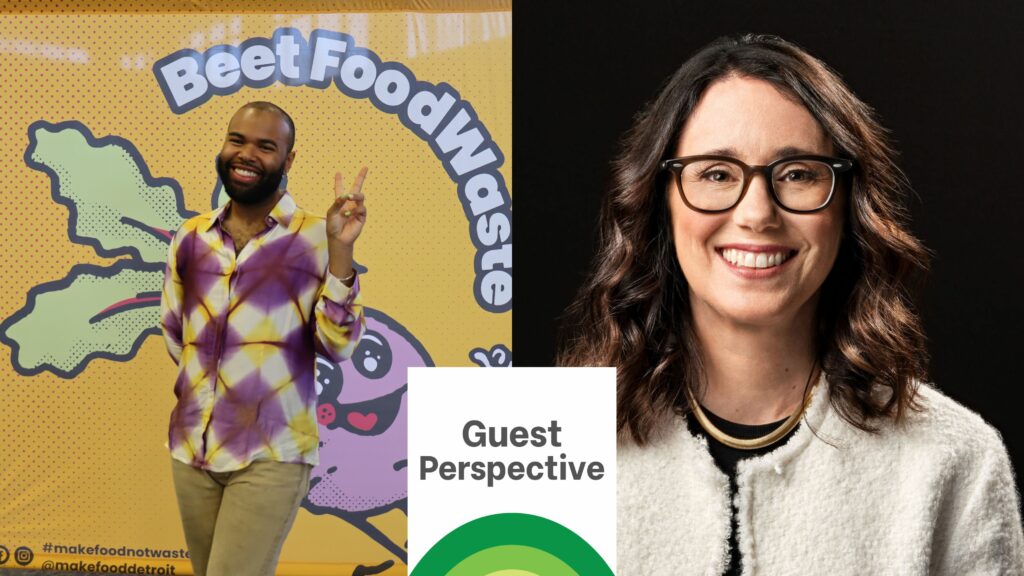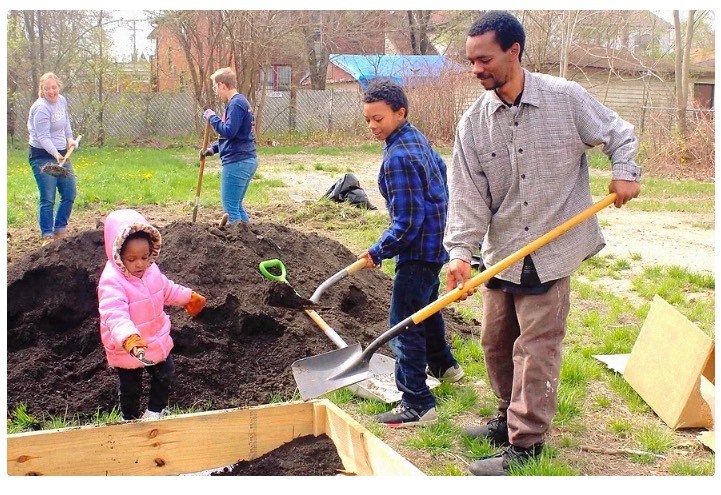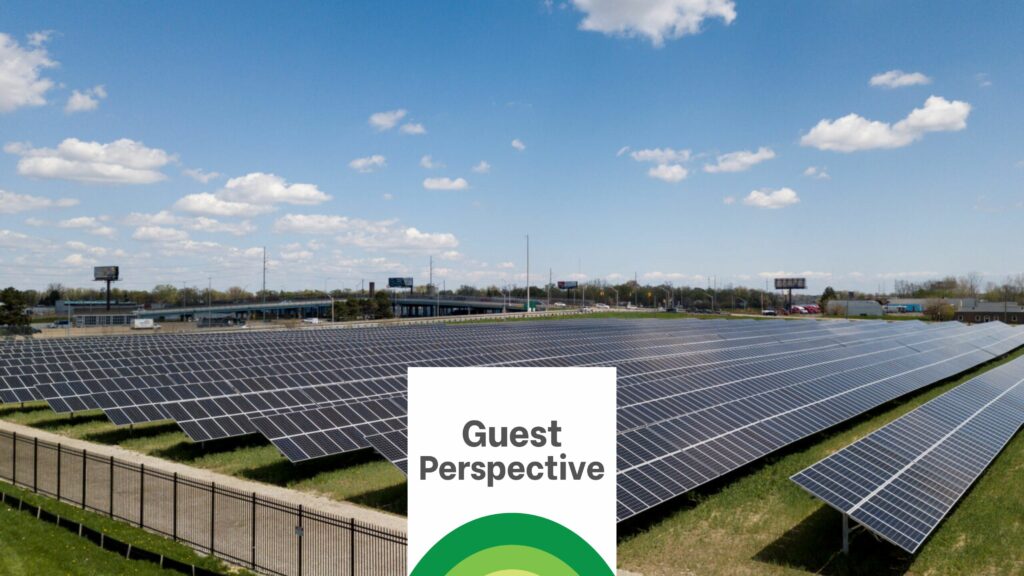New Detroit Director of Sustainability is Focused on Community

In March, Mayor Mike Duggan named longtime urban farming activist Tepfirah Rushdan as the city’s new director of sustainability. Rushdan was serving as Detroit’s first director of urban agriculture, where she worked to encourage urban farming by improving city policies and streamlining processes. Rushdan is helping lead the process of selecting a new director of urban agriculture, a position that will report to her. Rushdan also previously acted as codirector at Keep Growing Detroit, whose mission is for the majority of fruits and vegetables consumed by Detroiters to be grown in the city. She also is a co-founder of the Black Farmer Land Fund. She serves as treasurer of the Detroit People’s Food Co-op and is a cofounder of Black to the Land Coalition, which connects BIPOC people to outdoor recreation. She is also a board advisor to several other community projects and has formerly held seats at the Detroit Food Policy Council and the Uprooting Racism Planting Justice initiative. In her new role, Rushdan will lead the city’s priority actions within the four main goals of the Detroit climate strategy: Transitioning to clean energy Increasing sustainable mobility Accelerating energy efficiency and reducing waste Prioritizing vulnerable residents and adapting to change Reducing flood risks Protecting from extreme heat Improving air quality SBN Detroit interviewed Rushdan about her role, the challenges, and the opportunities. Q: How will you approach the four main goals of the Detroit climate strategy? A: The key for us to work across all departments within the city. There are some real champions in place who want to meet these goals and are already working to do so. My approach to tackling the four main goals involves fostering collaboration and synergy across all city departments. We are actively building out our capacity within my department to ensure that every arm of our municipal operations contributes to realizing our citywide sustainability vision. Q: You’ve said that you believe Detroit has real potential to become a national leader in municipal sustainability. What is your vision behind this? A: Being in Michigan, we have so many natural assets. Also, Detroit brings some things that may be seen as deficits, like vacant land and blighted areas, but I think these are big opportunities for us. It’s a chance to rethink what the city will look like in the coming years. Coming from an urban farming background, I’ve been thinking about the potential of this vacant land for many years, and I’m excited to find ways to repurpose it toward environmental goals – whether that’s farming, pollinators, solar, or other things. Also, Detroiters have grit. This is a city that’s been largely disinvested in, which has fostered strong resilience in our spirit. There is great potential here. Q: A major immediate focus is the city’s solar neighborhood project, which will replace up to 250 acres of vacant, blighted land in up to six neighborhoods with solar arrays that will create enough clean energy to power all of the city’s 127 municipal buildings. Can you tell us more about this project? A: This was largely driven by the people in the communities. The city put out a questionnaire regarding what the residents would like, and 19 groups responded saying they’d like to utilize the vacant land for projects. This city has met with them alongside other stakeholders and partners to determine what this might look like for the neighborhoods, the logistics of the sites, and so on. We currently have eight potential sites, and we are in meetings with the council to discuss moving forward with three of them for Phase One. We have selected two potential developers. The developers will work closely with the residents to lay out what the sites will look like in terms of design and aesthetics and work hand-in-hand with the neighborhoods. If all goes well with the city council, we’ll be able to start building as early as this fall. Q: What are the challenges of the project? A: I think there is a big opportunity to educate the public about climate change the issues that are at the forefront. It’s a chance to invest in the neighborhoods – communities that have not seen investment in years. This is a chance to spread that out. We’ll also be developing in the immediate areas around the footprints of the sites, investing in housing with energy upgrades, and more. So, I think it’s a chance for us to rise to the challenges of meeting the goals that the state of Michigan, the federal government, and the United Nations have outlined. This will take everyone working together including residents, businesses, and organizations. Q: Overall, do the city’s sustainability goals involve or play into workforce development? A: I’m proud of the work the city is doing around developing our workforce to be ready for the green economy. That’s pivotal. I want to highlight the Detroit At Work program where residents have opportunities to access careers and training. In fact, one of the new training options is around electric vehicle charging. The city is looking forward in terms of where the workforce needs to be and putting things in place for job creation toward these things. Q: What impact do you think your work will have on businesses and the economy? A: Sustainability is not exactly sexy. It takes a lot of work, commitment, and collaboration between businesses, residents, and all stakeholders. Business communities are driving our economy, so we need to be thinking about working alongside businesses to make sure their practices are sustainable. We all have to rethink how we are doing business and working together as a whole to reach our goals. Also, recently the city council unanimously passed the Energy and Water Benchmarking Ordinance requiring buildings with over 25,000 square feet of space to annually report their energy and water usage. This data will be gathered, and learnings and insights will be shared with other large business owners. Other cities have done this, and it’s been helpful. Q: What impacts are
Perspective on Eliminating Food Waste

DANIELLE TODD, IS THE EXECUTIVE DIRECTOR OF MAKE FOOD NOT WASTE Landfilled food is one of the primary sources of climate change due to two main reasons. First, food decomposing in landfills emits methane, a greenhouse gas 25 times more potent than carbon dioxide. Second, landfilled food represents a waste of land, water, and transportation resources that cannot be reclaimed. Given the substantial volume of food we send to landfills, methane emissions are skyrocketing and our resources are depleting at an alarming rate. Annually, Michiganders discard more than 2 billion pounds of food, resulting in approximately one-third of our landfills being composed of food waste. This excessive waste leads to the negative impacts of extreme weather such as flooding and power outages. It deteriorates air quality, threatens our food supply, and endangers vital plants and animals. Consequently, the State of Michigan, along with the U.S. government and the United Nations, has set a target to halve food waste by 2030. However, with 2 billion pounds of food still being landfilled annually, achieving this goal within six years presents a major challenge. Despite the fact that the problem is so great, eliminating food waste from our landfills is not all that difficult compared to other climate-related changes we need to make. Yes, it’s something we all must do, but it’s also something we all can do. According to the United Nations, more than half of the food waste comes from our homes. That means all of us can make a huge difference in this issue by changing how we handle food in our kitchens. For a fun way to get started, join our 7 Day Food Waste Challenge. You’ll learn the basics and begin to set up some habits that will drive down the amount of food you throw away. Of course, food waste happens outside of homes too. And if we’re going to reach the State’s goal in less than six years, we need a concerted plan. That’s why Make Food Not Waste has launched The 2030 Project, focusing on Southeast Michigan, the region with the highest population density. Concentrating efforts in this area is strategic, given that a larger population corresponds to greater amounts of waste. The project’s objective is to divert all food waste from landfills in the top 15 cities in the region. By collaborating with 17 local and national partners, Make Food Not Waste is crafting a detailed plan incorporating best practices in food waste reduction from across the country. The project’s approach underscores two critical principles: first, there is no singular solution to food waste. Second, we can only stop food waste by working together. While skeptics may argue that completely eliminating food waste from landfills is unattainable, we feel otherwise. It does not require the invention of groundbreaking technology or a defiance of natural laws. Rather, we simply need to stop throwing our food in the garbage. While establishing infrastructure, logistical frameworks, and educational programs pose challenges, they are not insurmountable. The alternative—continuing to waste our resources and make our planet hotter – is not something we can live with. Learn more at www.makefoodnotwaste.org. Be sure to subscribe to our newsletter for regular updates on sustainable business practices in and around Detroit.
EcoWorks: Addressing Climate Change by Enabling Sustainable Communities

EcoWorks is a nonprofit that works at the intersection of community development and sustainability. Based in Detroit, EcoWorks serves residents, households, community organizations, businesses, and municipalities, working to create just, equitable, and inclusive solutions to climate change. SBN Detroit spoke with Briana DuBose, EcoWorks executive director, to find out more. Q: Tell us about EcoWorks A: EcoWorks is a Detroit-based nonprofit that addresses climate change by enabling Michigan communities to be more environmentally and economically sustainable. We provide transformative climate and sustainable solutions for communities that are underserved and often unseen and unheard. We do this through community development, green consulting, home energy assistance, climate advocacy, education, and workforce development. Our Eco-D program is an equitable approach to securing affordable, healthy resilient homes and neighborhoods. We design and advocate solutions that promote utility affordability, housing security, climate resilience, and resident-led neighborhood development. We also work to engage community members to be part of learning about sustainability and provide direct service programs, upgrades and repairs, and more for underserved communities. Currently, we are working with four areas in Detroit – Hope Village, Southwest, Berg-Lahser, and Yorkshire Village to build out EcoDistricts. We offer comprehensive resources to help these areas transition to decarbonization and electrification. The program also provides residents and community organizations with resources to achieve healthy, affordable, resilient, and energy-secure homes and neighborhoods. Q: How do you work with Detroit neighborhoods and communities specifically? A: We look at ways to ensure the health and safety of all households. We focus on disadvantaged communities working with people who are vulnerable to the impacts of climate change – for example air quality. We partner with coalitions to improve policy and design innovative financial models for healthy, green, housing and neighborhoods. An example of this is River Rouge, which is surrounded by multiple plants and therefore has poor air quality. We go in and have workshops to discuss sustainability and energy-saving measures in their area. People are often surprised that asthma can be caused by poor air quality. We will go in and perform needs assessments on homes and work toward proper sealing and weather stripping and filters so the residents can have clean air in their homes. We also work with the communities in a bigger way to do things like build rain gardens, create green spaces, and more toward the things the specific areas need. Q: How does the Strategic Community Initiatives Program work? A: We develop custom-fit climate and energy solutions for municipalities, school districts, health systems, small businesses, and nonprofits. SCI has secured over $5 million in clean energy investments and over $30 million in lifetime savings for over thirty Michigan municipalities. EcoWorks serves as the lead technical provider as part of the Sacred Spaces Clean Energy Grants, eliminating disproportionate energy burdens for low-income congregations, inclusive of Black, Indigenous, and People of Color (BIPOC) communities statewide. Eleven houses of worship in low-income Michigan neighborhoods from Detroit to the Upper Peninsula will become more energy efficient with support from this $1.24 million grant of federal funds through the Michigan Department of Environment, Great Lakes, and Energy (EGLE) to make improvements that reduce their consumption of fossil fuels for electricity, heating, and cooling. From this, we expect the congregations to achieve a 15% energy savings that will go back into the communities. Q: How can a business in Southeast Michigan take advantage of EcoWorks? A: We bring a unique blend of people and change-management skills coupled with technical assessment and project management capabilities to businesses. Contact us and we’ll set up a meeting to talk. We can develop and manage holistic energy and climate action plans collaboratively for organizations. Q: How do you think EcoWorks impacts Southeast Michigan businesses? A: EcoWorks can help organizations stay nimble and resilient as energy costs and climate impacts rise. We can develop energy plans and implement energy projects by engaging people and bringing them together. We are often conveners. We are on the front line in communities, and we go into businesses to discuss how they may be contributing to the environment and sustainability in their communities. Often, businesses don’t know where to begin or may think sustainability initiatives are going to be expensive. We help educate them and show the ROI. Most businesses want to leave a better footprint on their community; they just need the resources to do so. Q: What are the biggest opportunities EcoWorks represents for Detroit? A: While our roots are firmly planted in energy conservation, we have grown to emphasize all aspects of sustainable development as it relates to building affordable, energy-efficient residential housing and commercial buildings. We are committed to promoting environmental equity and we take pride in helping communities get there. Be sure to subscribe to our newsletter for regular updates on sustainable business practices in and around Detroit.
DTE Energy’s Agenda for Mitigating Climate Change

SHAWN PATTERSON, VP, ENVIRONMENTAL MANAGEMENT AND SAFETY, DTE ENERGY, AND MEMBER OF THE SBND LEADERSHIP COMMITTEE, SHARES HIS PERSPECTIVE ON MITIGATING CLIMATE CHANGE AS A TOP PRIORITY. When you’ve been in business a while, you come to understand that there is no such thing as “just business.” What we do impacts our communities, our customers, and our world. That’s part of why, at DTE Energy, we’ve built sustainability into our plans for the future to help ensure that we’re going above and beyond for what matters most. CLIMATE CHANGE IS AN ERA-DEFINING ISSUE Climate change is one of the defining issues of our era. That’s why last fall, DTE Electric unveiled our 2022 CleanVision Integrated Resource Plan, our proposal to fundamentally transform the way we produce electricity in our state, accelerating coal plant retirements and investing in cleaner Michigan-made energy – including wind and solar parks – to accelerate reductions in carbon emissions. These plans include MIGreenPower which gives both business and residential customers the opportunity to support clean energy infrastructure right here in Michigan without needing to install or maintain it themselves. Michigan businesses have already gotten involved in this program in a big way. Corporate leaders Ford and Stellantis made two of the largest renewable energy purchases ever from a utility in the U.S. in 2022, adding more than 1,000 megawatts of renewable energy to their automotive operations. This, combined with more than 85,000 residential enrollees, the MIGreenPower program is on pace to avoid as many as three million tons of carbon dioxide emissions annually, helping create a cleaner future for all. While natural gas is one of the cleanest burning fossil fuels, we offer ways for customers to offset their natural gas usage, too, with the Natural Gas Balance program. For a small fee, the program uses carbon offsets to protect forests across the Upper Peninsula and support the advancement of non-fossil fuels with renewable natural gas. This program is designed to play a role as we aspire to reach net zero greenhouse gas emissions by 2050. ENERGY EFFICIENCIES We also strive to help the businesses that support our communities with ways to make their operations more energy efficient. With our business energy advisors, business owners can find the right energy-efficient solutions for their operations. From business-specific tips and changes to technologies to help make it easier, we are here to guide our customers toward a more energy-efficient way of doing business. But carbon reduction isn’t the only thing we’re working on. We also strive to build a Michigan-based set of suppliers. DTE has invested nearly $18 billion with Michigan-based suppliers since 2010, creating and sustaining 65,000 Michigan jobs. As a founding member of Pure Michigan Business Connect, we recognize the importance of connecting with local suppliers and we require that most new bids include at least two Michigan companies. Sustaining local businesses as well as our environment are key components to building a better future for all of Michigan. Be sure to subscribe to our newsletter for regular updates on sustainable business practices in and around Detroit.
Mitigating Climate Risks to Michigan’s Forestry Industry

More than half of Michigan is forested, with 20 million acres making up a vital part of the state’s landscape. Millions of acres of Michigan forest land are used to produce timber, a renewable and sustainably managed resource that supports many industries. The forests also provide other values, including wildlife habitat and watershed protection, and also help to sustain biodiversity. According to the Michigan Department of Natural Resources, the state’s forest products industries provide direct employment to almost 42,000 people, leading to $13.4 billion in economic output. Since 2014, jobs directly provided by forest products industries have increased by 9.7%. SBN Detroit spoke with DNR state forest planning and operations manager David Price about the impacts of climate change on Michigan forests, the trickle-down effect, and what can and is being done to mitigate risk. Q: How is climate change impacting forestry in Michigan? A: Forests have always been associated with Michigan. They’re a huge part of our social and economic fabric. Our forests support direct forestry jobs and also many other secondary industries. Trees are also important to our general well-being, mental health, and recreational pursuits. They help to regulate the global climate, absorbing a substantial portion of the fossil-fuel carbon emissions we humans produce. Climate change is driving concerns about forest health and productivity in many ways. Michigan is growing warmer and wetter, and there are projections that by the end of the century, the climate will be more like present Arkansas. Cold winters control and kill off certain insects that can be harmful to trees. Warmer winters mean these insects can be more persistent and harmful. Combine that with the fact that warmer weather can stress certain tree species and make them more susceptible to drought and less resistant to insects and disease, and we have a big problem. In Michigan, a good example of this is the hemlock woolly adelgid. We’ve been battling to contain this insect because it’s threatening to kill our hemlock trees along the coast of Lake Michigan. Cold winter weather helps to control the scale of this insect that spreads fungal disease, and warmer winters directly correlate to less winter mortality. There are operational considerations that climate change is causing as well. If the ground does not freeze, it’s significantly harder to harvest timber without causing extensive damage to the soils, potentially contributing to sediment moving into streams and wetlands. In Michigan, we have indigenous species such as red and jack pine, aspen, and boreal – spruces and firs – that are at the southern-most extent of their natural range in Michigan and they are not able to move quickly and adjust as the climate changes. A potential decline in the health and productivity of these tree species due to climate change will harm the values that they provide, including timber production, wildlife habitat, and carbon storage. An excellent example of this is the potential decline of jack pine forests in the northern Lower Peninsula which would cause a loss of habitat for the Kirtland’s warbler, a bird that is endemic to Michigan, recently removed from the endangered species list and proposed to be the new state bird of Michigan. So, as you can see, climate change is affecting our forest health and productivity in several ways. Q: What are the implications regarding business and the economy in Southeast Michigan? A: Michigan has a robust $22 billion forest-products industry. Most of the timber is harvested in northern Michigan, but secondary manufacturing occurs throughout the state, including Southeast Michigan. Many are surprised that Wayne County itself generates over a billion dollars in the forest products industry. The county’s paper products industry supports over 2,800 jobs alone. Think about sawmills in northern Michigan that then distribute products that are then sold at Menards, Home Depot, etc. This directly contributes to home construction in Southeast Michigan, which is also a huge industry. The bottom line is, maintaining a healthy and productive forest throughout the state is directly related to the economy in Southeast Michigan and the economy of the entire state. Q: What can be done to mitigate the risk to our forests, and what is the DNR doing about this? A: This is a million-dollar question. The happy news is that we can do things to change the outcome and the DNR has many initiatives in place. One simple thing we can do is plant trees. There is a lot of vacant land in northern Michigan that used to be forested. These areas are prime for reforestation. Planting trees is a great way to utilize nature for removing carbon from the atmosphere, and it’s underutilized in the state. The DNR plants over six million trees per year, most replacing forest that’s been harvested. The DNR has also initiated The Big Wild Forest Carbon Project, the first project in the nation to leverage the carbon storage capacity of trees on state forest lands. This pilot project captures carbon that is sequestered in trees and generated carbon credits. DTE Energy purchased the first decade of carbon offset credits to be used in their commercial natural gas programs. On a smaller scale, we are working offsetting power usage at our fish hatcheries through solar energy. We are also working with a company called Circle Power to develop two utility-scale solar energy projects on brownfield sites in the Upper and northern Lower Peninsulas. The DNR also partners with Michigan State University for some important research projects. First, we are evaluating assisted tree migration, which is a climate change adaptation strategy that involves moving trees or their genetic material from a known location to an area where they are presently well-adapted to an area where they are not currently present or prevalent, but where the trees may be better adapted to future climate under climate change projections. We are experimenting with new species and genetics of species and also identifying seed sources that may be better climate adapted to Michigan in the future to help the forest to
Gulay Serhatkulu, Setting the Right Priorities for a Climate Neutral and Circular Future

SBN Detroit interviews Dr. Gulay Serhatkulu, BASF Senior Vice President of Performance Materials North America. This business encompasses the entire materials know-how of BASF regarding innovative, customized plastics under one roof and is globally active in four major industry sectors – transportation, construction, industrial applications, and consumer goods. Serhatkulu joined BASF in 2006 as a technical service representative. She has held a variety of roles with increasing responsibility within BASF including product management, marketing, sales, strategy, and most recently procurement. Before BASF, she earned two postdoctoral appointments at the University of Nottingham, UK, and Wayne State University, respectively. Serhatkulu shares with us some insights on the projects, goals, and challenges she leads every day. Q: What is involved in your role in leading the sustainability team at BASF in the North American region? A: Plastics do have proven benefits during their use phase – for example, preservation of food loss, lightweight construction of vehicles, and building insulation. Plastic waste, however, and in particular plastic waste in the context of marine littering, is perceived as a major global challenge. There is also increasing regulatory pressure regarding recycling quota and recyclability on the one hand and strong commitments of our customers towards increasing the share of recycled material in their offerings on the other hand. Solving these challenges requires innovation and joint efforts globally across the value chain. A team across BASF has taken up this challenge and developed the ChemCycling™ project which focuses specifically on transforming plastic waste into a raw material using pyrolysis, a thermochemical process. The raw material can be fed into the existing assets to create new chemical products with excellent product performance based on recycled plastic waste. Besides ChemCycling, BASF offers other mass-balanced chemical or advanced recycling solutions based on different post-consumer and post-industrial feedstocks. In this case, the recycled feedstock is not a pyrolysis oil and is introduced as an intermediate during the manufacturing process and not at the very beginning as is the case of pyrolysis oil. Chemical recycling represents an exciting business opportunity for us and our customers, as the resulting products are of equal quality to the products derived from fossil feedstock. Nevertheless, many technical, economic, and regulatory questions have to be answered but we are eager to work on it and optimistic that we can cope with all challenges. Q: What are you currently working on in terms of sustainability for BASF? A: One great example is the BASF and Steelcase collaboration on the brand’s new Flex Perch Stool, which has sustainability and circularity at the forefront of its design. This is the first furniture product for Steelcase that uses plastics derived from a chemical or advanced recycling process. The stool is made with BASF’s Ultramid® B3EG6 Ccycled™, an injection moldable polyamide (nylon) 6 that utilizes material from a waste stream generated during electronics production and is a one-for-one replacement for the 100% fossil-derived plastics. I cannot stress enough the importance of value chain partnership to achieve these types of major breakthroughs. From a lightweight perspective, I can also point to a collaboration with Toyota on their Sienna. We also work with footwear companies to provide plastic and foam materials that have sustainability benefits such as being bio-based and recyclable. The new Sienna generation first-of-its-kind third-row free-standing seat backs. We also have efforts for Climate protection. Climate change and global warming are among the most pressing challenges of our time. On our journey toward climate neutrality, we have set ourselves ambitious goals and are striving worldwide to achieve net-zero CO2 emissions by 2050. At the heart of the long-term transition toward net-zero CO2 emissions by 2050 is the use of new technologies, which will replace fossil fuels such as natural gas with electricity from renewable sources. Additionally, we engage our suppliers in our ambition to serve our customers with the lowest carbon footprint materials possible. In our Supplier CO2 Management Program, we first aim to achieve transparency on the product-related CO2 emissions of our purchased raw materials. In this phase, we offer our support and share our knowledge on Product Carbon Footprint valuation methodologies and tools with our suppliers. Q: What are your longer-term goals there? A: We want to live up to our purpose: We create chemistry for a sustainable future. We are only successful if our products, solutions, and technologies add value to society. Therefore, we want to make a positive impact on society and safeguard our planet. To drive the sustainability transformation, we focus on three key topics: Climate change, Circular Economy, and a safe and sustainable portfolio. We are striving worldwide to achieve net-zero CO2 emissions by 2050. Q: What are the challenges you face? A: I see two main challenges. First, new technologies like electrically heated crackers, electric steam generation, carbon capture, and storage technologies need to be developed to achieve our targets. Some of these will take time to develop and they will first need to be piloted before being scaled up. Second, we need a supportive and enabling regulatory framework if the transformation is to succeed. Q: From your perspective, what role does BASF as a business play in terms of sustainability for the surrounding community? A: We measure the overall impact of economic, environmental, and social aspects of our business activities with our Value to Society methodology. We take sustainable use of water and preserving biodiversity seriously. Our global target is to implement sustainable water management at all production sites in water stress areas and our connected sites by 2030. We periodically investigate our production sites around the world to revise which are located near internationally protected areas. We connect with external stakeholders and networks to discuss our sustainability strategy. One local example is Fighting Island. Owned by BASF, Fighting Island is a 1,500-acre island on the Canadian side of the Detroit River in LaSalle, Ontario. The island was historically used for storage of lime tailings, a byproduct of soda ash production, in settling beds. Since closing the settling beds in 1982, BASF’s efforts have led to native revegetation and reforestation to help prevent erosion, reduce dust, increase wildlife habitat, control runoff, and enhance


